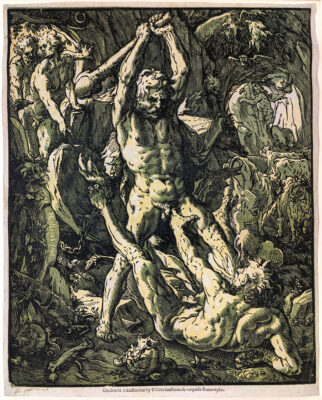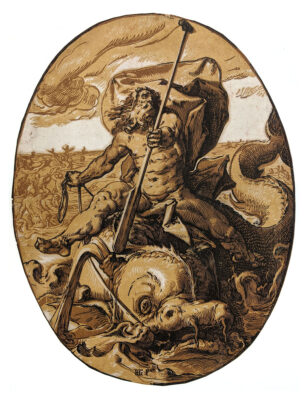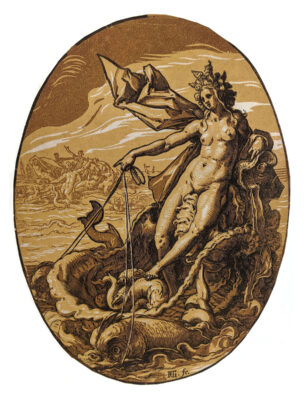HENDRICK GOLTZIUS
1558 Mülbracht – Haarlem 1617
Click images to toggle info
-
![Hercules and Cacus 1588]()
Hercules and Cacus 1588
chiaroscuro woodcut printed from three blocks in black, pale yellow, and olive green; 412 x 333 mm (16 3/16 x 13 1/16 inches)
Bartsch 231; Hirschmann and Hollstein 373; Strauss 403 third state (of four); Bialler (1983) 4 II color combination iv; New Hollstein 304 Ih
WATERMARK
circle with two arcs (similar to Meder, Dürer-Katalog, 258)
PROVENANCE
Otto Schäfer, Schweinfurt (his stamp not in Lugt)
his sale, Galerie Kornfeld, Berne, June 24, 1992, lot 160
LITERATURE
Hans Mielke, Manierismus in Holland um 1600: Kupferstiche, Holzschnitte und Zeichnungen aus dem Berliner Kupferstichkabinett, exhibition Kupferstichkabinett Berlin, 1979, cat. no. 5
Eva Korazija, Eros und Gewalt: Hendrik Goltzius und der niederländische Manierismus, exhibition Graphische Sammlung der ETH Zürich, 1982, cat. no. 24
Eckhard Schaar/Holger Broeker, Invenit et sculpsit: Zeichnungen und Graphik des niederländischen Manierismus, exhibition Hamburger Kunsthalle, 1992, cat. no. 22
Nancy Bialler, Chiaroscuro Woodcuts: Hendrick Goltzius and his Time, exhibition Rijksmuseum, Amsterdam/Museum of Art, Cleveland, 1992–93, pp. 103–114, cat. no. 25 second state (of six)
Dawn of the Golden Age: Northern Netherlandish Art 1580–1620, exhibition Rijksmuseum, Amsterdam, 1993–94, cat. no. 12 (Ger Luijten)
Christien Melzer, Virtuos imitiert: Die Meisterstiche des Hendrick Goltzius, exhibition Kunsthalle Bremen, 2014–15, cat. no. 10
Bernhard Barryte, Myth, Allegory, and Faith: The Kirk Edward Long Collection of Mannerist Prints, exhibition Cantor Arts Center, Stanford University, 2016, cat. no. 128
Susanne Pollack/Samuel Vitali, Sich kreuzende Parallelen: Agostino Carracci – Hendrick Goltzius, exhibition Graphische Sammlung der ETH Zürich, 2020–21, cat. no. 57 (Jana Graul)
Bernhard Barryte, Renaissance Impressions: Sixteenth-Century Master Prints from the Kirk Edward Long Collection, exhibition American Federation of Arts, New York, 2021, cat. no. 68A superb impression; with the usual horizontal drying folds, in overall extremely good, untreated condition and preserved with the publisher’s address below.
This impression of Goltzius’s most ambitious chiaroscuro woodcut still displays the more muted tonality that differs markedly from the brighter colors and intensified contrast of many later impressions; it is also unusual in that it maintains the publisher’s address below: Ghedruckt t’Amsterdam by Willem Janssen in de vergulde Sonnewyser. In most of the surviving impressions this has been trimmed off. Nancy Bialler has established that this address precedes a second one which foregoes the abbreviation and starts with “Ghedruckt tot Amsterdam …”
Willem Janszoon Blaeu was a cartographer who had studied cartography with Tycho Brahe in Alkmar. He started his own publishing house in 1604 and printed many chiaroscuro prints. He famously owned the blocks for Albrecht Dürer’s Rhinocerus (1515) and his Portrait of Ulrich Varnbühler (1522) for which he had tone blocks prepared to print both woodcuts in chiaroscuro. (Dürer himself never worked in this technique). Blaeu must have been in the possession of all three blocks for Goltzius’s Hercules and Cacus print (by then at least fifteen years old) and printed a variety of color combinations. The earlier ones, such as this one, follow the muted tonal range of the earliest surviving impressions more closely. In later printings, both the intensity of the colors and the starkness of the contrasts increase.
The print represents the culmination of Goltzius’s work in a technique with which he had experimented since 1585. “At the height of Mannerism, the visual arts were characterized by a marked emphasis on physicality. Sexuality was more piquantly represented than previously, emotions were more pronounced, and the depiction of strength and aggression was profoundly intensified.” With these two sentences Ger Luijten brilliantly condenses the essence of Dutch Mannerism before singling out Goltzius’s print as “an awesome prototype of masculine indomitability.” Luijten also showed that the figure of Hercules owes much to a 1524 engraving by Caraglio after Rosso Fiorentino depicting Hercules Fighting Cerberus. Goltzius himself only went to Italy in 1590, two years after the creation of this woodcut.
It is worth pointing out that the fight between Hercules and Cacus is not part of the Dodekathlos, the Twelve Labors the hero had to perform in the service of King Eurystheus. It is related, however, to the canonical tenth labor, Hercules’s theft of the cattle of Geryon. After having driven the herd through Spain and Italy, Hercules settled down for the night along the Tiber near present-day Rome when Cacus, the nefarious son of Vulcan, stole eight of the most
beautiful animals and hid them in his cave near the Aventine. Hercules ultimately caught up with him and made sure this became Cacus’s last misdeed. That the encounter took place in Rome explains why the literary tradition of the story is Latin and not Greek, going back to
Virgil’s Aeneid (8:190ff.) and Ovid’s Fasti (1:543–578) -
![Oceanus ca. 1589-90]()
Oceanus ca. 1589-90
chiaroscuro woodcut printed from three blocks in black, ochre, and brown; 346 x 262 mm (13 5/8 x 10 5/16 inches)
Bartsch 232; Hirschmann and Hollstein 367; Strauss 421; Bialler (1983) 6 color combination v; New Hollstein 296 color combination d
PROVENANCE
Henry F. Sewall, Boston (Lugt 1309)
Museum of Fine Arts, Boston, acquired with funds provided by Harvey D. Parker (Lugt 1870;
with the museum’s deaccession stamp Lugt 5156 with the pencil signature of Eleanor A. Sayre)
Colnaghi (their stock no. in pencil on verso C40269)
LITERATURE
Eckhard Schaar/Holger Broeker, Invenit et sculpsit: Zeichnungen und Graphik des niederländischen Manierismus, exhibition Hamburger Kunsthalle, 1992, cat. no. 29
Nancy Bialler, Chiaroscuro Woodcuts: Hendrick Goltzius and his Time, exhibition Rijksmuseum, Amsterdam/Museum of Art, Cleveland, 1992–93, pp. 121–124, cat. no. 27 color combination dA very good impression; the unprinted areas of the paper somewhat dusty, otherwise in good condition; trimmed on the borderline all round.
-
![]()
Tethys – Galatea ca. 1589–90
chiaroscuro woodcut printed from three blocks in black, ochre, and brown; 350 x 260 mm (13 3/4 x 10 1/4 inches)
Bartsch 235; Hirschmann and Hollstein 368; Strauss 422; Bialler (1983) 7 color combination iv; New Hollstein 296 IIIb
PROVENANCE
Henry F. Sewall, Boston (Lugt 1309)
Museum of Fine Arts, Boston, acquired with funds provided by Harvey D. Parker (Lugt 1870;
with the museum’s deaccession stamp Lugt 5156 with the pencil signature of Eleanor A. Sayre)
Colnaghi (their stock no. in pencil on verso C40271)
LITERATURE
Eckhard Schaar/Holger Broeker, Invenit et sculpsit: Zeichnungen und Graphik des niederländischen Manierismus, exhibition Hamburger Kunsthalle, 1992, cat. no. 30
Nancy Bialler, Chiaroscuro Woodcuts: Hendrick Goltzius and his Time, exhibition Rijksmuseum, Amsterdam/Museum of Art, Cleveland, 1992–93, pp. 125–129, cat. no. 28 state III b (of III b)
Bernhard Barryte, Myth, Allegory, and Faith: The Kirk Edward Long Collection of Mannerist Prints, exhibition Cantor Arts Center, Stanford University, 2016, cat. no. 127.3A fine impression; in very good condition, trimmed on the borderline all round.




